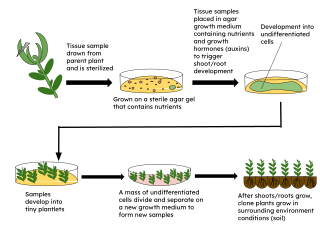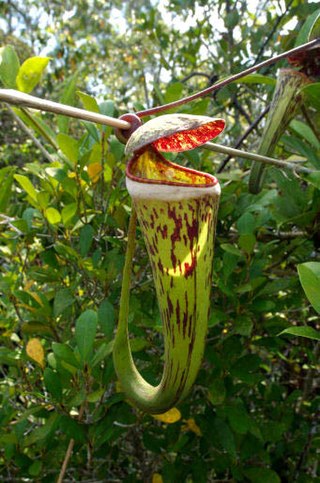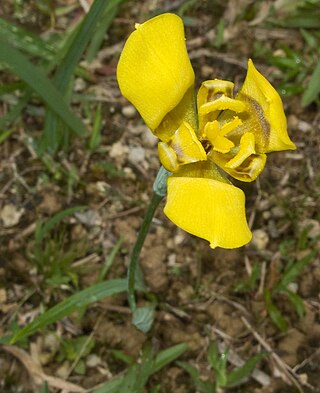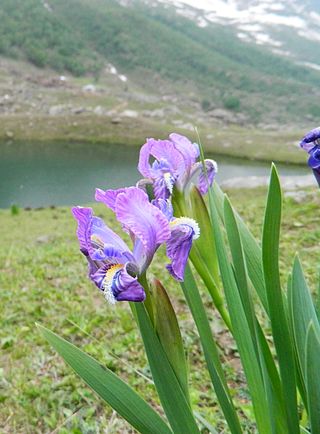
Vegetative reproduction is a form of asexual reproduction occurring in plants in which a new plant grows from a fragment or cutting of the parent plant or specialized reproductive structures, which are sometimes called vegetative propagules.

Chlorophytum comosum, usually called spider plant or common spider plant due to its spider-like look, also known as spider ivy, airplane plant, ribbon plant, and hen and chickens, is a species of evergreen perennial flowering plant of the family Asparagaceae. It is native to tropical and Southern Africa but has become naturalized in other parts of the world, including Western Australia and Bangladesh. Chlorophytum comosum is easy to grow as a houseplant because of its resilience, but it can be sensitive to the fluoride in tap water, which commonly gives it "burnt tips". Variegated forms are the most popular.

Micropropagation or tissue culture is the practice of rapidly multiplying plant stock material to produce many progeny plants, using modern plant tissue culture methods.

Kalanchoe beharensis is a plant species in the succulent genus Kalanchoe, and the family Crassulaceae. Kalanchoe beharensis is native to Madagascar known by local names mongy, rongy and tavitavy.

Nepenthes mapuluensis, the Mapulu pitcher-plant, is a species of tropical pitcher plant native to East Kalimantan, Borneo. It is known only from a restricted geographical range and is listed as Endangered on the IUCN Red List.

Kalanchoe daigremontiana, formerly known as Bryophyllum daigremontianum and commonly called mother of thousands, alligator plant or Mexican hat plant, is a succulent plant native to Madagascar. Like other members of Bryophyllum, it can propagate vegetatively from plantlets that develop on its leaf margins, as well as through upshoots from lateral roots, and seeds. All parts of this species contain a very toxic steroid known as daigremontianin.

Nepenthes × bauensis is a natural hybrid involving N. gracilis and N. northiana.

Nepenthes × cincta is a natural hybrid between N. albomarginata and N. northiana.

Nymphaea micrantha is a water lily belonging to the genus Nymphaea. It is native to the tropics of West Africa.

Trimezieae is a tribe included in the subfamily Iridoideae of the family Iridaceae. It is the smallest tribe in this subfamily, containing only three closely related genera.
Nariné Simonian is an Armenian-born French organist, pianist, musical director, and producer of operas. She specializes in baroque music, with a strong emphasis on Johann Sebastian Bach.
Shipwright is a specialist ship-modelling annual published by Conway Publishing. Its full title is Shipwright: The International Annual of Maritime History & Ship Modelmaking.

Iris virginica, with the common name Virginia blueflag, Virginia iris, great blue flag, or southern blue flag, is a perennial species of flowering plant in the Iridaceae (iris) family, native to central and eastern North America.

Trimezia martinicensis is a species of bulbous plant in the family Iridaceae. Originally from South America and the West Indies, it is now widely naturalized throughout the tropics. Common names include Martinique trimezia, yellow walking iris and forenoon yellow flag.

Wentbridge House Hotel is a hotel in Wentbridge, near Pontefract, West Yorkshire, England. It dates from 1700 and is built in the Georgian style. The house was occupied by many interesting people and was owned at one period by the Sayle family who lived in this area for several centuries. The property is now a hotel and provides accommodation, dining and function facilities

Trimezia fosteriana is a species of bulbous plant in the family Iridaceae. Due to the attractive aspect of its leaves and exuberant and delicate yellow flowers, it is widely used in cities in South America for ornamental purposes and gardening. This species is easily confused with Trimezia longifolia, due to the similarity of its yellow flowers. However, the latter species, placed in the genus Neomarica by some sources, is distinguished by the presence of a flattened (leaf-like) flower stem.
Iris longiscapa is a plant species in the genus Iris, it is also in the subgenus Iris and in the section Hexapogon. It is a rhizomatous perennial from the deserts of Kazakhstan, Tajikistan, Turkmenistan and Uzbekistan. They have grass-like leaves and lilac-violet or blue-purple flowers on a tall slender stem.

Iris hookeriana is a plant species in the genus Iris, it is also in the subgenus Iris and in the section Pseudoregelia. It is a rhizomatous perennial, from the Himalayan mountains of India and Pakistan. It has long pale green or yellow green leaves, long slender stem and fragrant blue, purple or lilac flowers, that are mottled with a darker colour. It is cultivated as an ornamental plant in temperate regions.

Iris sari is a species in the genus Iris, it is also in the subgenus Iris and in section Oncocyclus. It is from the rocky steppes and hills of Turkey. It has curved or straight leaves, cream, greenish or yellowish flowers which are variable and veined with crimson, purple-brown, reddish brown, reddish-purple or black. It has a dark maroon, rich crimson or brown signal patch and gold or yellow beard.

Trimezia candida, synonym Neomarica candida, also known as white walking iris, is species of flowering plant. It was first described by Emil Hassler and given the name Neomarica candida by Thomas Archibald Sprague. Trimezia candida belongs to the genus Trimezia and family Iridaceae.

















